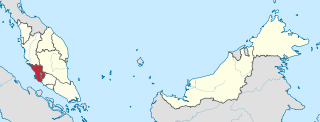
Selangor, also known by the Arabic honorific Darul Ehsan, or "Abode of Sincerity", is one of the 13 states of Malaysia. It is on the west coast of Peninsular Malaysia and is bordered by Perak to the north, Pahang to the east, Negeri Sembilan to the south, and the Strait of Malacca to the west. Selangor surrounds the federal territories of Kuala Lumpur and Putrajaya, both of which were previously part of it. Selangor has diverse tropical rainforests and an equatorial climate. The state's mountain ranges belong to the Titiwangsa Mountains, which is part of the Tenasserim Hills that covers southern Myanmar, southern Thailand and Peninsular Malaysia, with Mount Semangkok as the highest point in the state.

Rapid KL is a public transportation system owned by Prasarana Malaysia and operated by its subsidiaries Rapid Rail and Rapid Bus. The acronym stands for Rangkaian Pengangkutan Integrasi Deras Kuala Lumpur, which translates to Kuala Lumpur Rapid Integrated Transport Network in the Malay language. Rapid KL, with its 204.1 km (126.8 mi) of metro railway and 5.6 km (3.5 mi) of BRT carriageway, is part of the Klang Valley Integrated Transit System, operating throughout Kuala Lumpur and Selangor's satellite cities in the Klang Valley area.
Gamuda Berhad is an engineering, property and infrastructure company based in Malaysia. It is one of the largest Malaysian infrastructure companies and has undertaken various projects, both locally and overseas, like the construction of Klang Valley MRT lines, highways, airport runways, railways, tunnels, water treatment plants, dams, infrastructure concessions and the development of new townships.

Rail transport in Malaysia consists of heavy rail, light rapid transit (LRT), mass rapid transit(MRT), monorails, airport rail links and a funicular railway line. Heavy rail is mostly used for intercity services and freight transport as well as some urban public transport, while rapid transit rails are used for intracity urban public transport in the capital city of Kuala Lumpur and the surrounding Klang Valley region. There are two airport rail link systems linking Kuala Lumpur with the Kuala Lumpur International Airport (KLIA) and Sultan Abdul Aziz Shah Airport. The only-functioning monorail line in the country is also used for public transport in Kuala Lumpur, while the only funicular railway line is available in Penang.
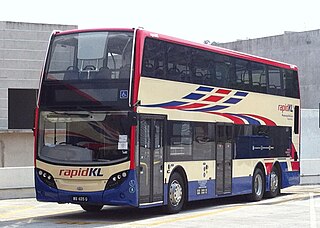
Rapid Bus Sdn Bhd is the largest bus operator in Malaysia operating mainly in urban areas of Klang Valley, Penang & Kuantan. As of February 2023, Rapid KL service brands unit of Rapid Bus, has operates 113 normal routes and also 69 MRT Feeder Bus routes, along with 8 Nadiputra routes in Putrajaya.
Transport in Greater Kuala Lumpur includes a road network, a railway network, airports, and other modes of public transport. Greater Kuala Lumpur is conterminous with the Klang Valley, an urban conglomeration consisting of the city of Kuala Lumpur, as well as surrounding towns and cities in the state of Selangor. The Klang Valley has the country's largest airport, the Kuala Lumpur International Airport (KLIA), as well as the country's largest intermodal transport hub and railway station, Kuala Lumpur Sentral.

The Sungai Buloh station is an integrated railway station serving the suburb of Sungai Buloh in Selangor, Malaysia, which is located to the northwest of Kuala Lumpur.
Rapid Rail Sdn Bhd is the operator of the rapid transit (metro) system serving Kuala Lumpur and the Klang Valley area in Malaysia. A subsidiary of Prasarana Malaysia, it is the sole operator of five rapid transit lines which collectively form the Rapid KL rapid transit system. The system currently consists of three light rapid transit (LRT) lines, two mass rapid transit (MRT) lines and a monorail line, with another MRT and LRT line currently under construction.
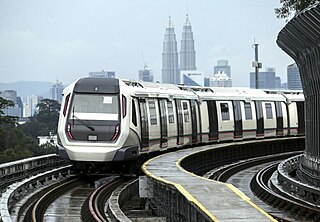
The MRT Kajang Line, previously known as the MRT Sungai Buloh–Kajang Line, is a Mass Rapid Transit (MRT) line servicing the Klang Valley, Malaysia. It is the second fully automated and driverless rail system in the Klang Valley region after the LRT Kelana Jaya Line. Owned by MRT Corp and operated as part of the Rapid KL system by Rapid Rail, it forms part of the Klang Valley Integrated Transit System. The line is numbered 9 and coloured green on official transit maps.

The MRT Putrajaya Line, is the second Mass Rapid Transit (MRT) line in Klang Valley, Malaysia, and the third fully automated and driverless rail system in the country. It was previously known as the MRT Sungai Buloh–Serdang–Putrajaya Line. The line stretches from Kwasa Damansara to Putrajaya and runs through densely populated areas such as Sri Damansara, Kepong, Batu, Jalan Ipoh, Sentul, Kampung Baru, Jalan Tun Razak, KLCC, Tun Razak Exchange, Kuchai Lama, Seri Kembangan and Cyberjaya.

The MRT Circle Line, also known as MRT 3, is a proposed thirteenth rail transit line, the third Mass Rapid Transit line and the fourth fully automated and driverless rail system in the Klang Valley, Malaysia. Once completed, this line would form the loop line of the Klang Valley Integrated Transit System. The director of this project is currently Tuan Haji Mohd Yusof Kasiron. The circle line will be numbered 13 and coloured grey on official transit maps.

Mass Rapid Transit CorporationSdn Bhd is a Malaysian state-owned company and a corporate body established under the Ministry of Finance (Incorporation) Act 1957. MRT Corp is fully owned by the Minister of Finance (Incorporated).

The Klang Valley Integrated Transit System is an integrated transport network that primarily serves the area of Klang Valley and Greater Kuala Lumpur. The system commenced operations in August 1995 with the introduction of commuter rail service on the existing rail between Kuala Lumpur and Rawang. The system have since expanded and currently consists of 11 fully operating rail lines in a radial formation; two commuter rail lines, six rapid transit lines, one bus rapid transit line and two airport rail links to the Kuala Lumpur International Airport's (KLIA) Terminal 1 and Terminal 2, and one temperarily suspended airport rail link to the Sultan Abdul Aziz Shah Airport. The system encompasses 528.4 kilometres (328.3 mi) of grade-separated route on standard gauge and metre gauge with 197 operational stations.
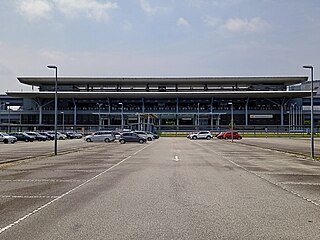
The Kwasa Damansara station is a mass rapid transit (MRT) station that serves the future township of Kwasa Damansara in Selangor, Malaysia, which is currently being developed. It is the first station of both the MRT Kajang Line and MRT Putrajaya Line.

The Phileo Damansara station is a mass rapid transit station serving the Phileo Damansara Commercial Centre and the northern sections of Petaling Jaya, Selangor, Malaysia.

The Pusat Bandar Damansara MRT Station, otherwise known as Pavilion Damansara Heights–Pusat Bandar Damansara MRT Station for sponsorship purposes, is a mass rapid transit (MRT) station serving the areas of Damansara Town Centre, Damansara Heights and Bangsar in Kuala Lumpur, Malaysia.

The Tun Razak Exchange (TRX) - Samsung Galaxy station is an underground mass rapid transit (MRT) station which serves the new Tun Razak Exchange (TRX) financial district, as well as the surrounding Jalan Tun Razak, Jalan Kamuning, Jalan Inai and Jalan Delima areas of Kuala Lumpur, Malaysia.
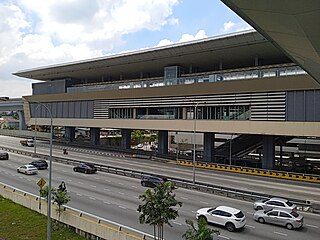
The Sri Raya MRT station is a Mass Rapid Transit (MRT) station serving the suburb of Batu 10 Cheras, Selangor, Malaysia. It serves as one of the stations on Klang Valley Mass Rapid Transit (KVMRT) Kajang Line. The station is located at 703 Telekom interchange of the Cheras–Kajang Expressway Cheras–Kajang Expressway.

The Bandar Tun Hussein Onn MRT station is a Mass Rapid Transit (MRT) station in Bandar Tun Hussein Onn, located in Cheras Selatan commune, Hulu Langat region, Selangor, Malaysia. It serves as one of the stations on the Klang Valley Mass Rapid Transit (KVMRT) Kajang Line. It was opened on 17 July 2017, together with the Phase 2 opening of the MRT line, along the Muzium Negara-Kajang stretch.

The Taman Tun Dr Ismail (TTDI) station, also known as TTDI-Deloitte due to sponsorship reasons, is a mass rapid transit station on the MRT Kajang Line serving the suburb of Taman Tun Dr Ismail, Kuala Lumpur and Damansara Utama, Petaling Jaya, Selangor, Malaysia.
















